Abstract
This study investigated the effects of adhesive resination and bamboo strand content on the physical and mechanical properties of thick Bamboo-Wood-oriented strand board (BWOSB), such as the air dry density (ADD), internal bond strength (IB), water absorption thickness swelling (TS), modulus of rupture (MOR), modulus of elasticity (MOE), and gluing properties. The raw materials used included large strands prepared from Chinese fir (Cunninghamia lanceolata), bamboo (Phyllostachys edulis), and modified isocyanate resin (PMDI). In this study, BWOSB specimens with different adhesive resination and bamboo strand content were fabricated, and their physical–mechanical properties were examined. It was found that the physical and mechanical properties of BWOSB with 8% PMDI resination were better than those with 5%, and their gluing damage was mostly in the form of the tearing of the raised vascular bundles of bamboo strands and the wood-breaking damage of wood strands. With the increase in the proportion of bamboo strands, the internal bonding strength and the short-span shear strength of BWOSB showed a tendency to decrease at first and then increase. The swelling rate of the water absorption thickness showed a tendency to decrease, and the other properties of BWOSB did not show a clear correlation with the change in the proportion of bamboo strands. The unique gluing interface between the bamboo and wood strands, which either used the “keyway” type of gluing effect or the “nail” type of gluing effect, determined the gluing performance of BWOSB, and the proportion of bamboo and wood strands influenced the gluing interface and gluing type of BWOSB, which ultimately affected the gluing performance of BWOSBs. The proportion of bamboo and wood strands also affected the gluing properties of BWOSBs by influencing the gluing interface and gluing type. This study provides a reference for the development of the production process of thick BWOSB and its application in the field of heavy load construction.
1. Introduction
Oriented strand board (OSB) is a multi-layered engineered wood panel manufactured through the hot pressing of flat, narrow strands of wood flakes. These flakes are coated with adhesive and arranged in a specific orientation to form the board []. OSB products are extensively utilized for building materials, particularly in applications that require load-bearing capabilities []. This is due to their remarkable advantages, including their efficient utilization of raw materials and the production of strong finished products. Currently, high-strength OSB products are also employed in various load-bearing applications, such as electromechanical packaging box boards/bottom boards, as well as materials for vehicle and ship manufacturing [], which has significantly broadened their range of applications. However, when it comes to electromechanical packaging box boards/bottoms, the performance requirements for OSB are considerably higher compared to standard OSB. For instance, in China’s standards, this type of OSB is expected to meet specific criteria, such as the longitudinal static flexural MOE and internal bonding strength requirements of no less than 9000 MPa and 1.7 MPa, respectively. In contrast, standard OSB is required to achieve minimum values of 3500 MPa and 0.3 MPa for these two indicators, respectively []. In order to achieve high-strength OSB capable of withstanding heavy loads, the industry primarily relies on increasing the product’s density. However, this approach poses challenges, such as the use of hot-pressing equipment and significantly increasing production costs []. Due to the superior performance of bamboo compared to ordinary wood, many researchers have started exploring the utilization of bamboo strands, either in whole or in part, as a replacement for wood strands in the production of high-strength Bamboo-Wood OSB (BWOSB) and all-bamboo OSB (BOSB). However, they have encountered specific adhesive challenges when compared to the conventional all-wood strand OSB []. In 2015, researchers found that when moso bamboo strands were mixed with poplar wood strands and subjected to hot pressing, the compression ratio of moso bamboo strands was only 1.1 due to their inherently high density. This value was significantly lower compared to the compression ratio of poplar wood strands, which was 2.8 []. In 2012 and 2019, it was found that the gluing performance was adversely affected when using bamboo strands. A pressing temperature of 180–200 °C and more than 20 min pressing time to soften and densify the bamboo shavings were required [,]. However, the hot-pressing temperatures and times commonly utilized in industrial practices do not meet this minimum requirement. In 2013, to address the aforementioned drawbacks, researchers also found that the PMDI adhesive, extensively applied in the industrial production of OSB, not only lowered the compression rate requirement for shavings but also minimized the TS in the final boards. This advantageous characteristic appeared to partially satisfy the demanding pressure specifications during the hot pressing of high-density bamboo shavings []. Furthermore, when bamboo shavings were subjected to cold water soaking treatment, certain extracts within the bamboo material were dissolved and eliminated. An important discovery in 2012 was that treating bamboo strands with cold water immersion resulted in the dissolution and removal of certain extracts present in the bamboo. This treatment led to improved adhesion between the bamboo strands and the adhesive, thereby reducing the water absorption thickness swelling of the resulting OSB []. At the same time, it was found that when the temperature reached 200 °C, the reticulation structure of lignin in wood was further enhanced but hemicellulose was significantly decomposed, which ultimately led to the greater hydrophobicity and dimensional stability of the wood and also resulted in smaller water absorption thickness swelling of BOSB [].
It can be seen that the differences in the biomass properties of bamboo and wood give BOSB or BWOSB very different gluing characteristics from those of all-wood-particle OSB. However, previous studies have predominantly focused on thin BOSB or BWOSB with a thickness of approximately 10 mm. Thin BOSB is mainly used in the ordinary particle board industry and in the traditional container floor industry; therefore, it is desired to develop thicker BWOSB to extend its applications. With the development of new wood-structure-building technology, BOSB and BWOSB may also be suitable for use in high-rise load-bearing structural parts due to their high strength. However, the requirements in terms of strength, deflection, and stability must be met for use in construction, which means that BOSB and BWOSB need to have good physical and mechanical properties and stability [,]. However, as there are limited studies on the related aspects, the aforementioned gluing problems may become more pronounced and severe when dealing with thicker BOSB or BWOSB (e.g., with a thickness exceeding 25 mm) that meet load-bearing requirements, or new gluing issues may arise. Therefore, this paper aims at investigating the impact of bamboo strands and the quantity of adhesive applied on the gluing performance of thick BOSB and BWOSB.
2. Materials and Methods
2.1. Materials
Phyllostachys edulis strands and Cunninghamia lanceolata were sourced from Fujian Yongan Forestry (Group) Co., Ltd., of Yongan City, Fujian, China. The statistical data regarding the fundamental morphology of the hand-picked strands used for board production are depicted in Figure 1 and Figure 2, respectively. Both types of strands were dried to achieve an average moisture content of 4%. The modified isocyanate resin PMDI: WANNATE 9132FC (Wanhua Chemical Group Co., Yantai, China).

Figure 1.
Statistics for length, width, and thickness of bamboo strands. (a) Length interval; (b) width interval; (c) thickness interval.

Figure 2.
Statistics for length, width, and thickness of China fir strand. (a) Length interval; (b) width interval; (c) thickness interval.
2.2. Methods
2.2.1. Preparation of BWOSB and BOSB
The intended final products were three-layer oriented strand boards (OSB), namely Bamboo-Wood OSB (BWOSB) and all-bamboo OSB (BOSB). The strand mass distribution for the finished boards was 20% in the upper layer, 20% in the lower layer, and 60% in the core layer. The upper and lower surface layers were oriented in the same direction, forming an angle of 30–40° with the length of the board. The core layer was positioned perpendicular (90°) to the upper and lower layers. The target density for the particle boards was set at 0.75 g/cm3, and the external dimensions were specified as 50 × 50 × 2.8 cm3 (length × width × thickness). For the production of BWOSB, five particle ratio comparison factors were established, based on the mass ratio of bamboo and wood particles. These ratios were 2:8, 3:7, 5:5, 7:3, and 10:0 (representing a pure bamboo-oriented strand board, BOSB). Additionally, two resination quantity comparison factors were considered, using PMDI resination quantities of 5% and 8% calculated based on the mass of the adiabatic particles. For the 8% PMDI resination, two resination contrast factors were set, and three pieces of finished BWOSB were produced for each level of contrast factor. This amounted to a total of 24 pieces of BWOSB and 6 pieces of BOSB that needed to be manufactured.
The hot-pressing temperature for both BWOSB and BOSB was set at 200 °C. The hot-pressing stages involved pressurization pressures of 6 MPa, 5 MPa, 3 MPa, and 1 MPa, with corresponding time durations of 8 min, 10 s, 10 s, and 10 s, respectively.
After the completion of the hot-pressing process, the finished boards were placed in a German BINDER climatic chamber set at a temperature of 20 °C and relative humidity of 65% for an equilibrium treatment period of 10 days. This treatment ensured that the boards reached stable moisture content and were ready for use.
2.2.2. Specimen Preparation and Test Method
According to the standards “LY/T1580-2010 Oriented Strand Board” [], “LY/T326-2020 Oriented Strand Board for Container Bottom Boards” [], and “GB/T 4897-2015 Particle Board” [], specific test indexes and specimen dimensions are required for sample preparation. In the case of BWOSB boards with different Bamboo-Wood strand proportions, the boards were cut into long strips measuring 500 × 50 × 28 mm3 in two directions, i.e., the transverse direction (perpendicular to the direction of surface strands) and longitudinal direction (parallel to the direction of surface strands), as illustrated in Figure 3a. These strips were used to conduct tests to determine the transverse MOR and static bending MOE for transverse specimens and the longitudinal MOR and static bending MOE for longitudinal specimens. Furthermore, the damaged test specimens were then cut into 50 × 50 × 28 mm3 blocks from both ends towards the middle, following the specimen numbering shown in Figure 3b,c (specimens No. 1–9). If a test specimen in a selected part was damaged, it was replaced by an adjacent test specimen in the same part. The remaining blocks were then renumbered based on the circle’s serial number, with an additional letter to account for the eliminated damaged blocks. The damaged blocks in the TS part of the figure were used for the 24-h water absorption thickness swelling test and were numbered as 1a, 2b, 3c, 4d, 6e, 7f, 8g, and 9h. The IB part of the specimen was designated for the IB test and numbered as 1i, 2j, 3k, 4l, 6m, 7n, and 8o. The ADD part of the specimen was used for the air dry density test and numbered as 3p, 4q, 4r, 5s, 5t, 6u, 6v, 7w, and 8o. Repeat specimens were also designated for the air dry density test, numbered as 3p, 4q, 4r, 5s, 5t, 6u, 6v, 7w, and 8x. The parameters of each test index are shown in Table 1.
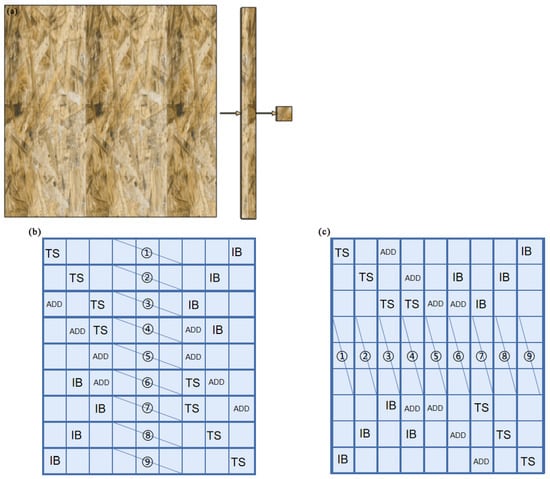
Figure 3.
Sawing and sampling diagrams for specimens. (The numbers in the figure are the transverse and longitudinal specimen numbers.) (a) Longitudinal sawing diagram; (b) transverse specimen sampling plan; (c) longitudinal sampling plan.

Table 1.
Testing arrangements for physical and mechanical properties of BWOSB.
2.2.3. Observation of Surface Morphology of Shavings and Specimens
A Zeiss Stemi 508 body electron microscope, Germany, (Beijing Groupca Technology Co., Ltd, Beijing, China) was used to observe the surface morphologies of the bamboo shavings, wood shavings, and specimens after the destruction of IB test for various types of particleboards. For bamboo shavings and wood shavings, the structural characteristics on the surfaces of the shavings were mainly observed, and the magnification of the microscope was 6×. For the surfaces of the specimens of each type of particleboard after the destruction of the internal bonding strength test, the surface morphologies of the gluing damage between bamboo shavings and bamboo shavings, between wood shavings and wood shavings, and between bamboo shavings and wood shavings were mainly observed, and the magnification of the microscope was also 6×.
3. Test Results and Analyses
3.1. Effect of Glue Application on the Strength of BWOSB Gluing
In Figure 4a, it is evident that the IB of all the BWOSB with different Bamboo-Wood particle ratios in this experiment exceeded the minimum requirement of 0.3 MPa specified by the standard for ordinary particleboards, “LY/T 1580-2010 Oriented Strand Board” []. However, none of them met the higher requirement of 1.7 MPa set by the standard “LY/T 3226-2020 Oriented Strand Board for Container Flooring Boards” []. Furthermore, as observed from Figure 4, among the BWOSB with varying Bamboo-Wood particle ratios, the IB of the BWOSB samples using 8% resination was higher compared to those using 5% resination. Additionally, the TS of the BWOSB with 8% resination was lower than that of the BWOSB with 5% resination.
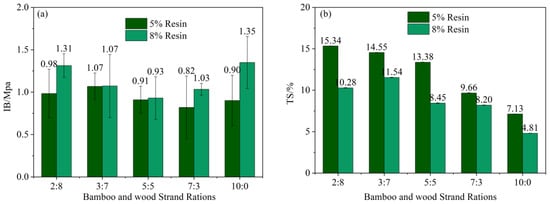
Figure 4.
Comparison of BWOSB gluing strength at different resination levels. (a) BWOSB IB; (b) BWOSB TS.
As depicted in Figure 5, the gluing damage observed in BWOSB specimens with different ratios of bamboo and wood strands primarily exhibited the tearing of bamboo filaments (vascular bundles) and breakage of wood strands on the surfaces of bamboo strands. Notably, the rates of tearing of bamboo filaments and breakage of wood strands in BWOSB samples treated with 8% resination were considerably higher compared to those treated with 5% resination. This stark contrast in gluing damage characteristics between the two resination percentages differed significantly from the interface gluing damage observed in pure wood strands and OSB, where the primary gluing damage involved the breakage of wood strands. It is worth noting that the information provided is based on observations made from Figure 5, highlighting the variations in the gluing damage patterns and the differences between the BWOSB samples with 8% resination and 5% resination, as well as their differences from the gluing damage patterns observed in pure wood strands and OSB []. The fundamental reason for this difference was the composition of the bamboo walls, which primarily consisted of basic thin-walled tissue and vascular bundles []. The surfaces of the bamboo flakes obtained through longitudinal cutting exhibited a longitudinal arrangement with alternating vascular and thin-walled tissues at regular intervals. The vascular tissues, known for their strength and hardness, naturally protruded, while the thin-walled tissues, which served as fillers and were comparatively softer, formed natural grooves []. Consequently, the raised filaments presented in the relatively weaker thin-walled matrix were the primary points of contact with the wood flakes during the hot-pressing process. Thus, they were more susceptible to tearing from the thin-walled matrix when subjected to damage. When a larger amount of waterproof adhesive was applied, the bonding between the larger wood flakes and the raised vascular bundles as well as the concave thin-walled tissues was enhanced. This simultaneous increase in bonding points contributed to the improved bonding strength and significantly reduced TS.
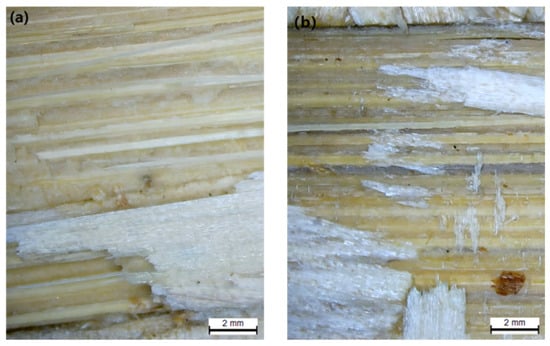
Figure 5.
Failure specimen of bonding strength in BWOSB. (a) Internal bonded specimens with 5:5 ratio of Bamboo-Wood strands at 5% resination; (b) internal bonded specimens with 5:5 ratio of Bamboo-Wood strands at 8% resination.
3.2. Effect of Bamboo Strand Content on the Gluing Strength and Water Resistance of BWOSB
In Figure 6, it is evident that as the proportion of bamboo strands increased, the IB of BWOSB initially decreased and then increased, while the overall TS exhibited a decreasing trend. This behavior can be attributed to the significant density difference between bamboo strands and wood strands, particularly when the mass ratio of bamboo to wood strands is 2:8, 3:7, and 5:5 []. Due to the overwhelming dominance of wood strands in the BWOSB composition at these ratios, the bonding between the BWOSB strands was primarily influenced by the wood strands. In this experiment, the Chinese fir strands utilized had flatter and softer surfaces, resulting in significantly better surface wettability compared to Bamboo-Wood []. Bamboo strands possess characteristics such as high density, hardness, and uneven surfaces, leading to their inferior surface wettability in comparison to wood strands. Consequently, the gluing interface characteristics and overall gluing effect of wood strands tended to be superior to those of bamboo strands, as depicted in Figure 5 and Figure 7. Furthermore, during the hot-pressing process, bamboo strands exhibited greater and longer heat softening compared to wood strands. The increasing quantity of bamboo strands in the BWOSB composition affected the overall softening of the entire slab and the response of the core layer to the final hot-pressing pressure. As a result, the internal bonding strength of BWOSB gradually decreased. However, when the ratios of bamboo to wood strands were 7:3 and 10:0 (i.e., all bamboo strands), the quantity of bamboo strands became the dominant factor in the BWOSB composition. Consequently, the gluing between the strands was primarily influenced by the bonding of bamboo strands. In this scenario, as the number of bamboo strands increased in the BWOSB, the softening of the entire slab and the response of the core layer to the final hot compression pressure gradually became more uniform and consistent. This led to improved gluing conditions in the core layer, resulting in naturally higher IB. These findings aligned with the results reported by other academics [].
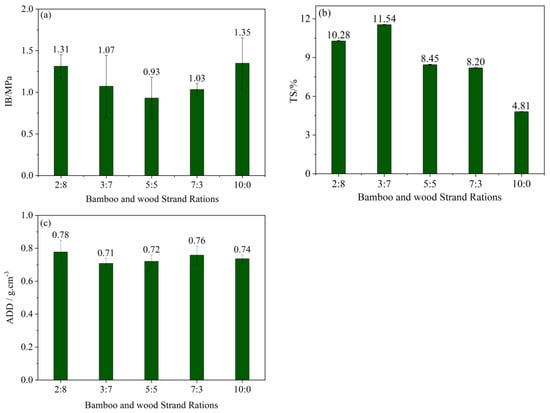
Figure 6.
Physical and mechanical properties of BWOSB at 8%PMDI resination. (a) BWOSB IB; (b) BWOSB TS; (c) BWOSB gas dry density.
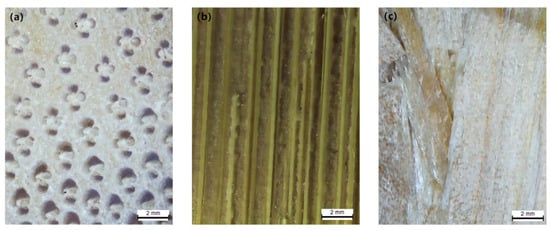
Figure 7.
Phenomenological view of the structure of different parts of bamboo flakes. (a) Bamboo cross-section; (b) bamboo longitudinal cross-section; (c) fir strand surface.
Due to its higher density and the presence of a natural hydrophobic siliceous component, bamboo has found application in a diverse range of fields []. Furthermore, the actual compression rate achieved during the hot compression molding of bamboo is typically smaller than that of wood. As a result, the overall water absorption thickness swelling of BWOSB tended to decrease as the number of bamboo strands increased, as illustrated in Figure 5b. This observation aligned with the findings of other academics who have utilized poplar wood strands and bamboo strands to produce composite particleboards. In Figure 6b, it can be observed that the water absorption thickness swelling of BWOSB with a ratio of 2:8 bamboo to wood strands was unusually large. This can be attributed to two main factors. Firstly, the hand-laying method employed in this experiment was prone to causing unevenness in the arrangement of the slabs. Secondly, the actual density of BWOSB with this Bamboo-Wood ratio was 0.71 g/cm3, which was 5.33% lower than the target density of 0.75 g/cm3, as illustrated in Figure 6c.
3.3. Effect of Bamboo Strand Content on the Physical and Mechanical Properties of BWOSB
As depicted in Figure 8a, there was no clear pattern observed regarding the influence of the bamboo strand content on the longitudinal/transverse static flexural MOE and short-span MOE of BWOSB. This can be attributed to several factors. Firstly, there was greater variability in the morphologies of both the bamboo strands and wood strands used in this experiment, as shown in Figure 1 and Figure 2. Additionally, the hand-assisted loading method employed may have further contributed to the inhomogeneity of the actual ratios of the two types of strands within each layer of the slabs. Such factors collectively contributed to the irregular variation in the MOE in the static bending elasticity of BWOSB at each ratio. Moreover, the significant differences between bamboo strands and wood strands in terms of heat and moisture transfer further contributed to the absence of a clear pattern in their effect on the longitudinal/transverse static bending elasticity and short span of the finished boards. The dissimilarities in heat softening behavior between bamboo strands and wood strands during the hot-pressing process of the slabs exacerbated the irregularity in the transfer of heat and moisture throughout the entire hot-pressing process. This, combined with the substantial differences in the gluing interface and gluing methods between the two types of strands, ultimately led to the observed results.
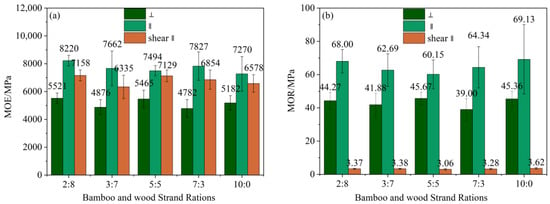
Figure 8.
BWOSB physical and mechanical properties. (a) BWOSB MOE; (b) BWOSB MOR.
In Figure 8b, it is evident that the longitudinal/transverse static bending strength of BWOSB initially decreased and then increased with the increase in the bamboo strand content. This trend aligned with the effect observed for bamboo strand content of 2.2 on the IB of BWOSB. This is because the static modulus of rupture (MOR), especially in the case of short spans, primarily assesses the shear resistance in the core layer during the static bending process. In wood-based panels, the shear resistance of the core layer is positively correlated with the IB of the core layer. This observation highlights that the gluing performance of thick BWOSB plays a pivotal role in determining its key mechanical properties.
In general, the MOEs of all BWOSB (Bamboo-Wood particleboard) ratios, with 8% resination, surpassed the 3500 MPa threshold specified in the standard “LY/T 1580-2010 Oriented Strand Boards” for ordinary particleboard. However, they did not meet the higher requirement of 9000 MPa specified in the “LY/T 3226-2020 Oriented Strand Boards for Container Flooring Boards” for load-bearing structural boards [].
3.4. Unique Gluing Interface between Bamboo Strands and Wood Strands
As shown in Section 2.2.1, Section 2.2.2, and Section 2.2.3, the physical and mechanical properties of BWOSB were strongly influenced by the ratios of bamboo and wood strands, as well as the unique gluing interface and gluing method employed for these two materials.
Figure 9a,b and Figure 10a,b provide visual representations and physical diagrams illustrating the gluing interfaces of “Bamboo-Wood strands” and “bamboo–bamboo strands”, respectively. These diagrams highlight the distinctive characteristics resulting from the natural anatomical structure of bamboo and the specific chipping and forming process of bamboo chips. The surfaces of bamboo chips exhibited prominent concave–convex grooves, representing thin-walled basic tissues, as well as grooves corresponding to vascular bundles, being arranged longitudinally at regular intervals in the depicted diagrams. Consequently, during the spray gluing process, a significant portion of the adhesive spots tended to accumulate within these grooves present on the surfaces of bamboo strands. Furthermore, the inherent properties of bamboo strands, being denser and harder, made it more challenging for the adhesive spots to achieve complete contact with the neighboring surfaces of the strands. This phenomenon explains why BWOSB requires a larger amount of adhesive application to attain superior bonding strength when compared to wood-only-oriented strand board (OSB), as described in Section 2.1.
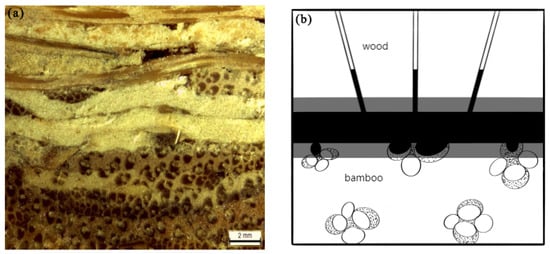
Figure 9.
Bamboo strands glued to wood strand interface. (a) Cross-section of Bamboo-Wood glued interface; (b) Bamboo-Wood glued interface [].
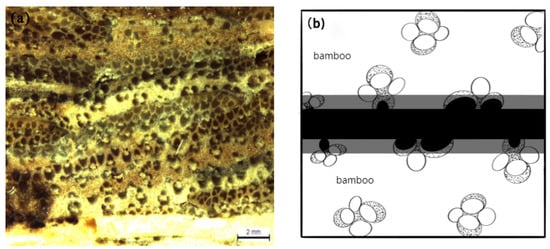
Figure 10.
Bamboo strands and bamboo strand glued interface (a) Cross-section of bamboo–bamboo glued interface; (b) bamboo–bamboo glued interface [].
The bonding process for conventional “wood–wood” strands primarily involved the adhesive penetrating the cells of the truncated rays within the wood fibers, resulting in the formation of what is commonly referred to as “glue nails” []. In the case of “Bamboo-Wood” strands, the gluing process involved different mechanisms. On the bamboo strand side, bonding was primarily achieved through the adhesive that remained within the grooves on the surfaces of the bamboo strands. These adhesive-filled grooves created a form of “bonding groove” that helped to establish a bond between the bamboo strands and the adjacent strands. On the other hand, on the wood strand side, the adhesive penetrated the cells of the truncated rays in the wood fibers, forming what is referred to as “glue nails”. This mechanism provided a strong bond between the wood strands, enhancing the overall bonding strength of the composite material. In the case of “bamboo–bamboo” strands, the gluing process does not involve the formation of “glue nails”, as seen in wood-based materials. Unlike wood, bamboo does not possess transverse ray cells that contribute to the formation of such adhesive penetration and bonding mechanisms.
In Figure 6a, Figure 9b and Figure 10b, it is evident that as the proportion of bamboo strands increased, the IB of BWOSB exhibited a unique pattern of initially decreasing and then increasing. This phenomenon can be explained as follows.
When the ratios of bamboo to wood strands were 2:8, 3:7, and 5:5, although the number of wood strands was larger, there was a decreasing trend. Consequently, the bonding between the strands in BWOSB was primarily achieved through “nail” gluing, but with a decreasing trend. Simultaneously, there was an increasing trend in “keyway” gluing, which refers to the adhesive bonding within the grooves presented on the surfaces of the bamboo strands. These changes in gluing mechanisms ultimately impacted the IB of BWOSB. When the ratio of bamboo to wood changed from 7:3 to 10:0, the number of bamboo strands became higher and exhibited an increasing trend. Additionally, the bonding between the strands in BWOSB was predominantly achieved through “keyway” gluing, which also showed an increasing trend. Normally, with such conditions, the strength of the internal bond would be expected to decrease. However, in reality, it showed an increasing trend. This unexpected trend can be attributed to the difference in the speed of softening between bamboo and wood strands during the hot-pressing process, as described in Section 2.2. This difference triggered variations in the response to the internal hot-pressing stress of the slab, leading to the observed discrepancy in IB.
The unique gluing interface and gluing mechanism of bamboo and wood strands played a crucial role in determining the overall gluing performance of BWOSB. Meanwhile, the ratio of bamboo and wood strands directly impacted the gluing performance of BWOSB by influencing the gluing interface and gluing type within the composite material.
4. Conclusions
Based on the aforementioned experimental results and analyses, the following conclusions can be drawn.
- (1)
- The thick BWOSB samples with 5% and 8% PMDI resination exhibited good IB, longitudinal/transverse static flexural MOE, longitudinal/transverse MOR, short-span shear strength, and 24-h water absorption thickness swelling rates, which met the requirements of the standard “LY/T 1580-2010 Oriented Strand Boards”. However, they did not meet the requirements of the standard “LY/T 3226-2020 Requirements of Oriented Strand Board for Container Base Board”. Notably, the properties of BWOSB with 8% PMDI resination were superior to those with 5% resination. The observed primary gluing damage in BWOSB was the tearing of raised vascular bundles in large-sized bamboo particles and the breaking of large-sized wood particles.
- (2)
- As the proportion of bamboo strands increased, the IB and short-span shear strength of BWOSB demonstrated a trend of initially decreasing and then increasing. Conversely, the TS showed a decreasing trend. However, no clear correlation was observed between the other properties of BWOSB and the proportion of bamboo strands.
- (3)
- As the proportion of bamboo strands increased, when wood strands accounted for the majority of BWOSB strands, the gluing between the strands was primarily of the “nail” type, but with a decreasing trend. Simultaneously, “keyway” gluing exhibited an increasing trend. Consequently, the IB and short-span shear strength of BWOSB gradually decreased. On the other hand, when bamboo strands accounted for the majority of BWOSB strands, the gluing between the strands was dominated by the “keyway” type, which showed an increasing trend. As a result, the IB and short-span shear strength of BWOSB increased.
Wood and bamboo are polar materials, containing certain polar groups, such as -OH; modified PMDI is a solvent-free, single-component, wet-curing polyurethane reactive adhesive with a large number of polar groups, such as -NCO, -OH, which very easily reacts with other polar groups to form a strong chemical bond. The pH value of Phyllostachys edulis is usually in the range of neutral to slightly alkaline, and that of Cunninghamia lanceolata is usually in the range of neutral to alkaline. The pH value of the modified PMDI adhesive is alkaline. Generally speaking, Phyllostachys edulis and Cunninghamia lanceolata are more compatible with the PMDI adhesive under alkaline conditions, which can result in good initial adhesive strength and form a good adhesive effect between bamboo and wood shavings [,]. Meanwhile, the ratio of bamboo to wood strands directly affects the gluing performance by influencing the gluing interface and gluing type within BWOSB.
Author Contributions
Conceptualization, X.G. and W.C.; methodology, X.W.; writing—original draft preparation, B.Y.; writing—review and editing, G.D. and C.D. All authors have read and agreed to the published version of the manuscript.
Funding
The present work was financially sponsored by the National Natural Science Foundation of China, grant number 31960291; Yunnan Agricultural Joint Specialization, grant number 202301BD070001-060; and Yunnan Provincial Reserve Program for Young and Middle-Aged Academic and Technical Leaders, grant number 202305AC160074.
Data Availability Statement
Not applicable.
Acknowledgments
We are very grateful to Zhang Linjun from the Beijing Representative Office of Dieffenbacher Maschinen und Anlagenbau GmbH, Germany, for providing us with the raw material.
Conflicts of Interest
The authors declare that they have no conflict of interest to report regarding the present study.
References
- Zhou, D.; Hua, Y. Wood-Based Panel Processing, 2nd ed.; China Forestry Press: Beijing, China, 2002; pp. 207–231. [Google Scholar]
- Xu, B. Stiffness Modeling and Process Research of OSB-Veneer Composite Container Bottom. Ph.D. Thesis, China Nanjing Forestry University, Nanjing, China, 2008; pp. 1–5. [Google Scholar]
- Fu, W.S.; Zhou, J.P. Operational test and optimization of bamboo OSB pilot line. For. Sci. 2012, 48, 164–169. [Google Scholar] [CrossRef]
- GB/T 4897-2015; Particle Board. GB Standards: Beijing, China, 2015.
- LY/T 1580-2010; Oriented Strand Board. LY Standards: Beijing, China, 2010.
- LY/T 3226-2020; Oriented Strand Board for Container Flooring. LY Standards: Beijing, China, 2020.
- Semple, K.E.; Zhang, P.K.; Smola, M.; Smith, G.D. Hybrid Oriented Strand Boards Made from Moso Bamboo (Phyllostachys pubescens Mazel) and Aspen (Populus tremuloides Michx.): Uniformly Mixed Single Layer Uni-Directional Boards. Eur. J. Wood Prod. 2015, 73, 515–525. [Google Scholar] [CrossRef]
- Yong, C.; Guan, M.J.; Zhang, Q.S. Selected Physical and Mechanical Properties of Bamboo and Poplar Composite OSB with Different Hybrid Ratios. Key Eng. Mater. 2012, 517, 87–95. [Google Scholar] [CrossRef]
- Sun, Y.; Jiang, Z.; Zhang, X.; Sun, Z.; Liu, H. Behavior of Glued Laminated Bamboo and Bamboo-Oriented Strand Board Sheathing-to-Framing Connections. Eur. J. Wood Prod. 2019, 77, 1189–1199. [Google Scholar] [CrossRef]
- Chaowana, P. Bamboo: An Alternative Raw Material for Wood and Wood-Based Composites. JMSR 2013, 2, 90. [Google Scholar] [CrossRef]
- Febrianto, F.; Sahroni; Hidayat, W.; Bakar, E.S.; Kwon, G.-J.; Kwon, J.-H.; Hong, S.-I.; Kim, N.-H. Properties of Oriented Strand Board Made from Betung Bamboo (Dendrocalamus asper (Schultes.f) Backer ex Heyne). Wood Sci. Technol. 2012, 46, 53–62. [Google Scholar] [CrossRef]
- Kamperidou, V. Chemical and Structural Characterization of Poplar and Black Pine Wood Exposed to Short Thermal Modification. Drv. Ind. 2021, 72, 155–167. [Google Scholar] [CrossRef]
- Yang, F. Process Research and Performance Prediction of Bamboo Recombinant Material/OSB Composites. Ph.D. Thesis, China Academy of Forestry Sciences, Beijing, China, 2014; pp. 1–64. [Google Scholar]
- Breyer, D.E.; Fridle, K.J.; Cobeen, K.E.; Pollock, D.G. Design of Wood Structures-ASD/LRFD, 6th ed.; America McGraw-Hill: New York, NY, USA, 2007; pp. 8.1–10.54. [Google Scholar]
- Iswanto, A.H.; Idris, M.; Sucipto, T. Effect of bamboo strand length on oriented strand board. IOP Conf. Ser. Earth Environ. Sci. 2019, 260, 012039. [Google Scholar] [CrossRef]
- Liu, Y.; Zhao, G.; Li, J. Wood Science, 2nd ed.; China Forestry Press: Beijing, China, 2012; pp. 257–275. [Google Scholar]
- Wang, G. Bamboo/Fir Laminated Composites and Their Properties. Ph.D. Thesis, China Academy of Forestry Sciences, Beijing, China, 2003; pp. 17–188. [Google Scholar]
- Wang, G.; Jiang, Z.H.; Yu, W.J. Microscopic deformation process of bending and shear damage of moso bamboo/fir laminated timber. J. Northeast. For. Univ. 2008, 36, 27–29. [Google Scholar] [CrossRef]
- Manandhar, R.; Kim, J.-H.; Kim, J.-T. Environmental Social and Economic Sustainability of Bamboo and Bamboo-Based Construction Materials in Buildings. J. Asian Archit. Build. Eng. 2019, 18, 49–59. [Google Scholar] [CrossRef]
- Wahan, M.Y.; Zhang, Z.; Meng, X.; Gao, Y.; Ji, X. Mechanical behavior of GFRP-bamboo composite shear connections. Constr. Build. Mater. 2022, 331, 127–333. [Google Scholar] [CrossRef]
- Zhao, K.; Wei, Y.; Chen, S.; Hang, C.; Zhao, K. Experimental investigation of the long-term behavior of reconstituted bamboo beams with various loading levels. J. Build. Eng. 2021, 36, 102107. [Google Scholar] [CrossRef]
- Fei, H.; Zhang, H. The bond-groove gluing effect of bamboo. J. Bamboo Res. 2008, 27, 50–52. [Google Scholar]
- Gu, F.; Wang, W.; Li, H. (Eds.) Lignocellulosic Pretreatment and Its High-Value Applications, 2nd ed.; Chemical Industry Press: Beijing, China, 2019; pp. 1–76. [Google Scholar]
- Li, Z.; Zhao, S.; Wang, Z.; Zhang, S.; Li, J. Biomimetic Water-in-Oil Water/PMDI Emulsion as an Excellent Ecofriendly adhesive for Bonding Wood-Based Composites. J. Hazard. Mater. 2020, 396, 122722. [Google Scholar] [CrossRef] [PubMed]
Disclaimer/Publisher’s Note: The statements, opinions and data contained in all publications are solely those of the individual author(s) and contributor(s) and not of MDPI and/or the editor(s). MDPI and/or the editor(s) disclaim responsibility for any injury to people or property resulting from any ideas, methods, instructions or products referred to in the content. |
© 2023 by the authors. Licensee MDPI, Basel, Switzerland. This article is an open access article distributed under the terms and conditions of the Creative Commons Attribution (CC BY) license (https://creativecommons.org/licenses/by/4.0/).